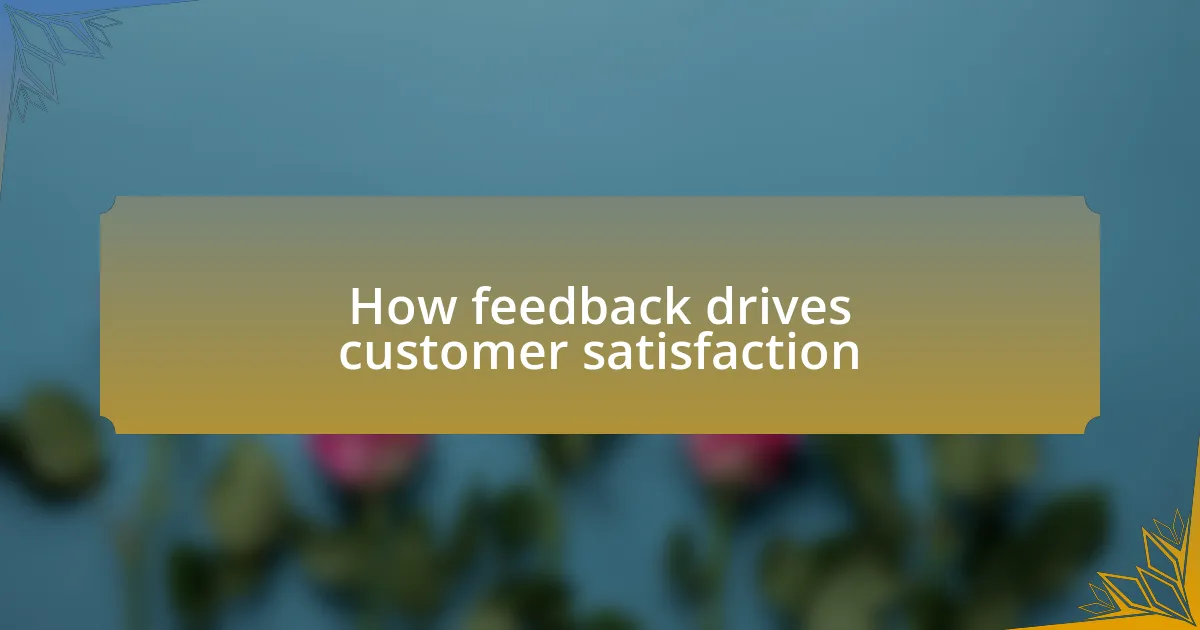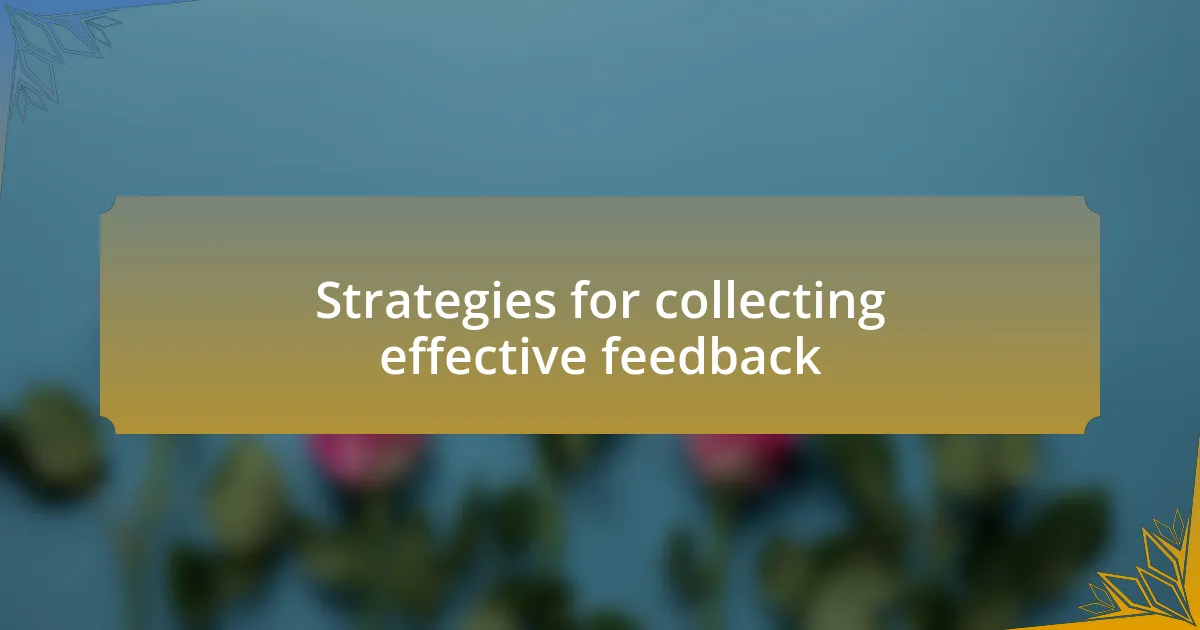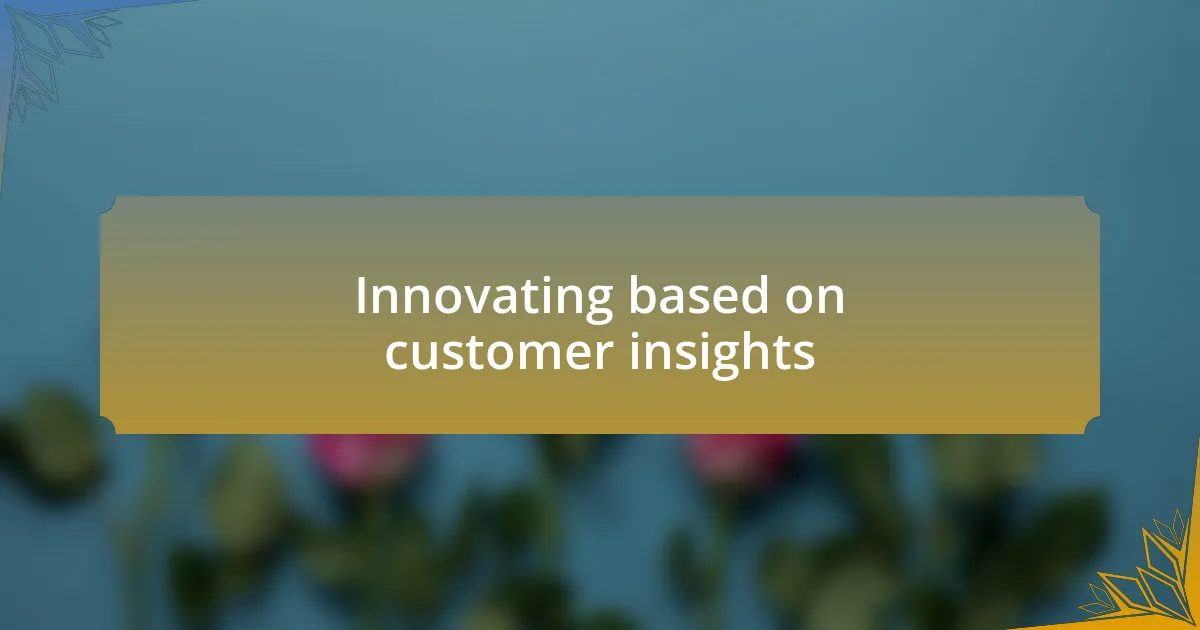Key takeaways:
- Customer experience conferences facilitate meaningful dialogue and diverse perspectives, fostering innovation through shared insights.
- Feedback is essential for innovation and customer satisfaction; it transforms assumptions into actionable improvements.
- Effective feedback collection strategies include direct interactions, targeted surveys, and community forums to deepen customer engagement and loyalty.
- Innovating based on customer insights enhances user experience and fosters a collaborative relationship between businesses and customers.

Understanding customer experience conferences
Customer experience conferences serve as vibrant hubs where industry leaders, innovators, and practitioners congregate to share their insights and strategies. I remember my first conference—walking into a room buzzing with excitement and ideas sparked a fire within me. It made me wonder: how could a simple exchange of thoughts lead to transformative changes for businesses?
These events are not merely about presentations; they are opportunities for meaningful dialogue and connection. I’ve often found that the most impactful moments occur during informal conversations over coffee breaks, where genuine relationships blossom. Have you ever felt that rush when you connect with someone who truly understands your challenges? That’s the magic of these gatherings.
Attending a customer experience conference helped me realize how diverse perspectives contribute to innovation. It challenged me to think beyond my own experiences and explore how different industries tackle similar obstacles. Have you ever considered how a technique from one sector could revolutionize your approach? It’s in these exchanges that the seeds of innovation are sown, making these conferences invaluable for anyone looking to enhance their customer experience strategy.

Importance of feedback in innovation
Feedback is the lifeblood of innovation. I recall a project I worked on where we launched a new product feature without actively seeking customer input. The result? A lack of engagement and several missteps that could have been avoided. If I had embraced feedback earlier, we could have avoided a lot of headaches and made the feature something customers actually wanted.
In another instance, I participated in a brainstorming session where customer feedback was the primary focus. I found it fascinating how one suggestion led to a complete overhaul of our approach. Have you ever experienced that “aha” moment when a single piece of feedback changes everything? It’s in those moments that you realize how vital each customer’s voice is in shaping innovation.
The iterative nature of innovation demands that we constantly listen, adapt, and refine. I’ve learned that gathering feedback isn’t just about collecting data; it’s about fostering a culture that champions conversation. When you actively prioritize customer input, you open doors to more creative solutions that resonate deeply with your audience. Isn’t it incredible how a simple comment can spark groundbreaking ideas?

How feedback drives customer satisfaction
Feedback plays a crucial role in driving customer satisfaction. I recall a time when I managed a service that struggled with high churn rates. After diving into customer feedback, it became evident that users felt overlooked. Once we acted on their insights and tailored our approach, I witnessed a remarkable turnaround in customer loyalty and happiness. Isn’t it amazing how listening can transform satisfaction levels?
On another occasion, I rolled out a feature based solely on my assumptions. When customers expressed their discontent, it struck me hard—the emotional connection we have with our users is often the key to satisfaction. Feedback isn’t just a checkbox; it’s a vital dialogue that shapes the experience. Wouldn’t you agree that actively incorporating feedback can turn a mediocre service into a beloved one?
Ultimately, the heart of customer satisfaction lies in continuous engagement and responsiveness. I’ve seen firsthand how businesses that genuinely integrate feedback into their processes not only improve their offerings but also create a community of loyal customers. It raises the question: how often are we truly listening to those we serve? The answer can lead to profound changes in satisfaction and success.

Strategies for collecting effective feedback
One effective strategy for collecting feedback is to leverage direct customer interactions. I once implemented feedback kiosks in our physical locations, allowing customers to share their thoughts on the spot. The immediacy of this approach really surprised me; we gathered insights that were fresh and often emotional, revealing sentiments that might have been forgotten by the time traditional surveys reached them. Have you ever considered how much richer feedback could be in the moment?
Another approach I found impactful was using targeted surveys tailored to specific interactions. After a purchase or support call, I sent out concise surveys focusing on those experiences. Customers appreciated the request for their insights right when their feelings were most vivid. This kind of timely feedback allowed me to make immediate adjustments and reinforce a positive experience. Isn’t it fascinating how small adjustments can lead to big improvements?
Finally, I’d recommend creating community forums or discussion groups to gather ongoing feedback. In one of my previous roles, I set up a dedicated space where customers could share ideas and suggestions. The sense of community it fostered was incredible. I realized that when customers feel they have a stake in shaping the service, their loyalty deepens. Why not consider building such spaces where your customers can feel heard and valued?

Innovating based on customer insights
Innovating based on customer insights requires a genuine commitment to listening and adapting. I remember when we unveiled a new feature based on customer requests. After implementing changes to our mobile app, we kept a close eye on user engagement. The surge in positive feedback validated our efforts, proving how directly responding to user insights can spark enthusiasm and foster loyalty. Have you experienced that buzz when a customer praises a change you’d made just for them?
In another instance, I participated in a design thinking workshop where we brainstormed potential enhancements derived from customer personas. We crafted solutions not just for demographic groups, but for real individuals who had shared their stories and pain points. By humanizing the data, we designed an experience that resonated deeply with our audience, transforming abstract insights into relatable innovations. Can you imagine the magic of creating something that truly resonates with your customers’ needs?
Finally, I’ve found that regular customer insight sessions can lead to groundbreaking innovations. Once, we invited a group of customers to preview a prototype and provide feedback. Their enthusiastic reactions and constructive criticism shaped the final product in ways I had never anticipated. It made me realize that co-creating with customers doesn’t just drive better design; it creates a sense of ownership that customers relish. How powerful is it to have your customers as collaborators in innovation?